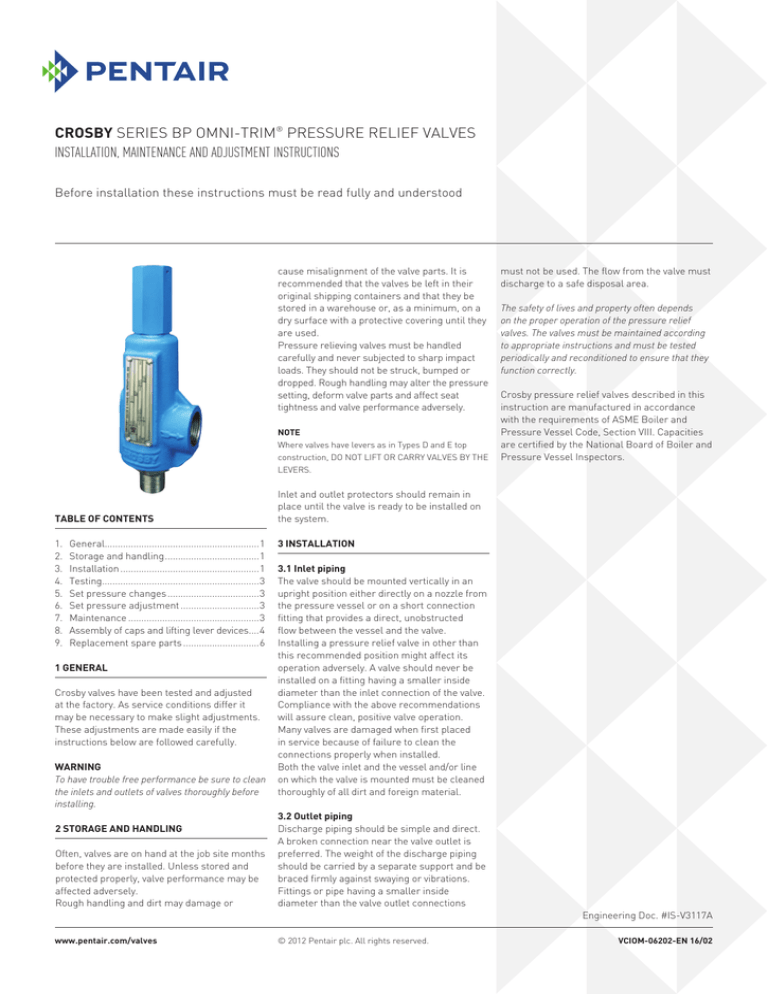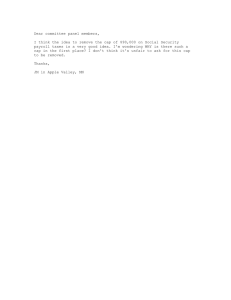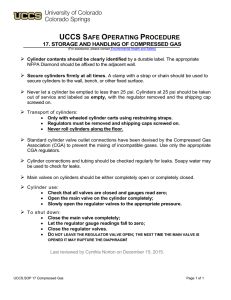
CROSBY SERIES BP OMNI-TRIM® PRESSURE RELIEF VALVES
INSTALLATION, MAINTENANCE AND ADJUSTMENT INSTRUCTIONS
Before installation these instructions must be read fully and understood
cause misalignment of the valve parts. It is
recommended that the valves be left in their
original shipping containers and that they be
stored in a warehouse or, as a minimum, on a
dry surface with a protective covering until they
are used.
Pressure relieving valves must be handled
carefully and never subjected to sharp impact
loads. They should not be struck, bumped or
dropped. Rough handling may alter the pressure
setting, deform valve parts and affect seat
tightness and valve performance adversely.
NOTE
Where valves have levers as in Types D and E top
construction, DO NOT LIFT OR CARRY VALVES BY THE
LEVERS.
TABLE OF CONTENTS
1.General............................................................1
2. Storage and handling.....................................1
3.Installation......................................................1
4.Testing............................................................3
5. Set pressure changes....................................3
6. Set pressure adjustment...............................3
7.Maintenance...................................................3
8. Assembly of caps and lifting lever devices.....4
9. Replacement spare parts..............................6
1 GENERAL
Crosby valves have been tested and adjusted
at the factory. As service conditions differ it
may be necessary to make slight adjustments.
These adjustments are made easily if the
instructions below are followed carefully.
WARNING
To have trouble free performance be sure to clean
the inlets and outlets of valves thoroughly before
installing.
The safety of lives and property often depends
on the proper operation of the pressure relief
valves. The valves must be maintained according
to appropriate instructions and must be tested
periodically and reconditioned to ensure that they
function correctly.
Crosby pressure relief valves described in this
instruction are manufactured in accordance
with the requirements of ASME Boiler and
Pressure Vessel Code, Section VIII. Capacities
are certified by the National Board of Boiler and
Pressure Vessel Inspectors.
Inlet and outlet protectors should remain in
place until the valve is ready to be installed on
the system.
3 INSTALLATION
3.1 Inlet piping
The valve should be mounted vertically in an
upright position either directly on a nozzle from
the pressure vessel or on a short connection
fitting that provides a direct, unobstructed
flow between the vessel and the valve.
Installing a pressure relief valve in other than
this recommended position might affect its
operation adversely. A valve should never be
installed on a fitting having a smaller inside
diameter than the inlet connection of the valve.
Compliance with the above recommendations
will assure clean, positive valve operation.
Many valves are damaged when first placed
in service because of failure to clean the
connections properly when installed.
Both the valve inlet and the vessel and/or line
on which the valve is mounted must be cleaned
thoroughly of all dirt and foreign material.
Often, valves are on hand at the job site months
before they are installed. Unless stored and
protected properly, valve performance may be
affected adversely.
Rough handling and dirt may damage or
3.2 Outlet piping
Discharge piping should be simple and direct.
A broken connection near the valve outlet is
preferred. The weight of the discharge piping
should be carried by a separate support and be
braced firmly against swaying or vibrations.
Fittings or pipe having a smaller inside
diameter than the valve outlet connections
www.pentair.com/valves
© 2012 Pentair plc. All rights reserved.
2 STORAGE AND HANDLING
must not be used. The flow from the valve must
discharge to a safe disposal area.
Engineering Doc. #IS-V3117A
VCIOM-06202-EN 16/02
CROSBY SERIES BP OMNI-TRIM® PRESSURE RELIEF VALVES
INSTALLATION, MAINTENANCE AND ADJUSTMENT INSTRUCTIONS
Cap
Adjusting bolt
Adjusting bolt nut
Spring washer (top)
Spindle
Spring
Spring washer (bottom)
Guide
Seal and wire
* Cylinder vent hole
Piston O-ring
Guide O-ring
Disc holder
Disc insert
Cylinder O-ring
Seat O-ring
Cylinder
Base
* This vent must remain open
Threaded connection
Series BP
2
CROSBY SERIES BP OMNI-TRIM® PRESSURE RELIEF VALVES
INSTALLATION, MAINTENANCE AND ADJUSTMENT INSTRUCTIONS
4 TESTING
7 MAINTENANCE
Testing should be performed by trained
personnel using the applicable test procedure.
Follow these guidelines for performance of the
set pressure test:
7.1 Dismantling
1. Remove the cap.
2. Before removing the adjusting bolt, take a
measurement from the top of the adjusting
bolt to the top of the cylinder as a reference
for resetting the valve later.
3. Loosen the adjusting bolt nut and turn the
adjusting bolt counterclockwise to remove
the load on the spring completely. Unless
this is done, unnecessary damage to the
seat or misalignment of the trim parts may
occur when the valve is reassembled.
4. Loosen the base from the cylinder but do
not remove.
5. Place the valve, upside down, in a vise and
remove the base.
6. Remove the guide and disc assembly as a
unit. A screwdriver or other suitable tool
can be inserted into the cylinder vent hole to
facilitate removal of the guide.
7. Remove the disc holder from the guide.
8. Remove the cylinder from the vise and
remove the spindle, spring and spring
washers.
9. Remove the disc insert by inserting a drive
pin or similar tool into the hole in the
disc holder and press out the disc insert.
Remove the O-ring with a suitable tool.
Be careful not to damage the O-ring groove.
10.Remove the guide O-ring, piston O-ring and
cylinder O-ring.
4.1 Test fluids - set pressure test
The test fluid should be air or nitrogen for
valves used on gas and vapor service and water
for valves used on liquid service.
4.2 Temperature correction
When a valve is set on air or water at room
temperature and then used at a higher service
temperature, the cold differential set pressure
shall be corrected to exceed the set pressure
using the following temperature correction:
Operating temperature
ºF
ºC
0 to +150
-18 to +66
+151 to 400
+66 to +204
% Pressure
increase
1%
4.3 Valve operation
Valves intended for compressible fluid service
and tested on air or nitrogen will open with a
sharp, clear popping action at the set point.
Valves for liquid service tested with water
are considered open at the first continuous
unbroken stream of liquid flowing through the
valve. Sometimes it is helpful to install a short
piece of pipe in the valve outlet to determine the
opening on water.
5 SET PRESSURE CHANGES
Set pressure changes beyond the specified
spring range will necessitate a change in the
valve spring assembly consisting of the spring
and two washers.
The new spring and washers must be obtained
from Pentair and the valve must be reset and
the nameplate restamped by an authorized
repair facility.
6 SET PRESSURE ADJUSTMENT
Before making any adjustments, reduce the
pressure under the valve seat to at least 25%
below the stamped opening pressure. This
will prevent seat damage due to turning of the
disc insert on the nozzle seat and minimize the
chance of an inadvertent opening.
Cleaning
The following instructions are general
guidelines. Certain applications may require the
use of special cleaning procedures.
1. After the valve has been dismantled
completely, the seats on both the nozzle
and the disc insert should be examined to
determine how badly they are damaged,
if at all. Any severe damage may make it
advisable to replace the parts.
2. External parts, such as the cylinder and cap,
can be cleaned by immersion in a bath such
as a hot oakite solution or equivalent.
3. Internal parts, except O-rings, can be
cleaned using acetone, denatured alcohol
or any other suitable solvent. Mechanical
cleaning of internal parts, except seats,
can be performed using fine sandpaper or
emery cloth.
3
CROSBY SERIES BP OMNI-TRIM® PRESSURE RELIEF VALVES
INSTALLATION, MAINTENANCE AND ADJUSTMENT INSTRUCTIONS
7.2 Assembly
1. Prior to assembly the following surfaces are
to be coated with pure nickel “Never-Seez”:
(see Figure 1)
- Base to cylinder threads
- Spring washer bevels
- Adjusting bolt threads
- Cap threads
- Cap to cylinder sealing surfaces
2. Prior to assembly the guide surface of
the guide is to be lightly coated with
Dow Corning 3451 grease.
3. All O-rings except the piston O-ring
and TFE O-rings are to be coated with
Dow Corning 3451.
4. The piston O-ring is to be coated with
Dow Corning 3451.
5. Place the spring and washers onto the spindle.
6. Place the spindle/washer/spring assembly
into the cylinder. With the spindle protruding
through the top of the cylinder while
inverting the cylinder, place the inverted
cylinder into a vise.
7. Coat the entire guide O-ring with Dow
Corning 3451 and install on the guide.
8. Coat the entire seat O-ring (except TFE seat)
with Dow Corning 3451. Insert the O-ring
into the groove in the disc holder. Push the
disc insert into the disc holder. Installing
the disc insert with a TFE O-ring or a high
durometer elastomer may require a small
press.
9. Coat the entire piston O-ring with a small
amount of Dow Corning 3451 and install
onto the disc holder.
10.Install the disc holder into the guide.
11.Install the guide/disc holder assembly into
the cylinder.
12.Coat the cylinder O-ring with Dow Corning
3451 and install into the cylinder.
13.Screw the base into the cylinder until tight
(locked).
14.Screw the adjusting bolt nut onto the
adjusting bolt and install into the cylinder.
15.Screw the cap onto the cylinder with a
suitable wrench until tight.
8 ASSEMBLY OF CAPS AND LIFTING LEVER
DEVICES
Type A (screwed cap)
Apply pure nickel Never-Seez or equivalent to
the cap sealing surface and screw the cap onto
the top of the cylinder. Tighten the cap with a
suitable wrench.
Type B (screwed cap with test rod)
Apply pure nickel Never-Seez to the cap sealing
surface and screw the cap onto the top of
the cylinder. Tighten the cap with a suitable
wrench. Install the cap plug O-ring and screw
the cap plug into the cap. The test rod is
installed only during system hydrostatic testing.
Never install the test rod unless performing
system hydrostatic testing.
Type D (packed lifting lever)
1. Apply Loctite 242 or equivalent to the
spindle threads. Screw the spindle nut onto
the spindle. Screw the cap hand tight.
2. Apply Dow Corning 3451 or equivalent to the
cam O-ring and install onto the cam. Insert
the cam into the sleeve. Install the lever
onto the cam and secure with the lever pin.
3. Screw the lever assembly into the cap. If the
cam interferes with spindle nut, remove the
spindle assembly and raise the spindle nut.
Repeat until the spindle nut is approximately
1/16” above the cam.
4. Once the spindle nut is in position, remove
the cap and screw the locknut on the
spindle and, while securing the spindle
nut firmly with locking pliers, tighten the
locknut.
5. Apply pure nickel Never-Seez or equivalent
to the cap threads and to the cap sealing
surface. Screw the cap onto the top of the
cylinder. Tighten the cap with a suitable
wrench.
6. Apply Dow Corning 3451 or equivalent to the
cam sleeve O-ring and install the O-ring.
Install the lever assembly.
Type E (packed lifting lever with test rod)
Assembly of the Type E lifting lever is identical
to the Type D with the addition of the cap
plug O-ring and the cap plug. The test rod is
installed only during system hydrostatic testing.
Never install the test rod unless performing
system hydrostatic testing.
4
CROSBY SERIES BP OMNI-TRIM® PRESSURE RELIEF VALVES
INSTALLATION, MAINTENANCE AND ADJUSTMENT INSTRUCTIONS
Cap threads
(Never-Seez)
FIGURE 1
Adjusting bolt threads
(Never-Seez)
Cap to cylinder
sealing surface
(Never-Seez)
Spring washer bevels
(Never-Seez)
Piston O-ring
(Dow Corning 3451)
Guide Surface
(Dow Corning 3451)
This vent must
remain open
Guide O-ring
(Dow Corning 3451)
Seat O-ring
(Dow Corning 3451)
Cylinder O-ring
(Dow Corning 3451)
Base to cylinder threads
(Never-Seez)
Cap
Cap plug
Cap plug
Cap plug O-ring
Locknut
Cap
Cap plug O-ring
Cam sleeve O-ring
Cam sleeve
Spindle nut
Cam
Lever pin
Cap
Cam O-ring
Lever
Type B
Type A
Test rod
Type E
Cam sleeve O-ring
Locknut
Cam sleeve
Spindle nut
Cam
Lever pin
Cam
Cam O-ring
Lever
View showing valve gagged
with test rod
Type D
5
CROSBY SERIES BP OMNI-TRIM® PRESSURE RELIEF VALVES
INSTALLATION, MAINTENANCE AND ADJUSTMENT INSTRUCTIONS
9 REPLACEMENT SPARE PARTS
9.1 Ordering information
Pentair recommends that a sufficient inventory
of spare parts be maintained to support
process requirements. Always be sure to use
genuine Pentair parts to ensure continued
product performance and warranty.
9.2 Parts
To order parts, the following information always
should be included:
1.Quantity
2. Part name, i.e. (disc insert)
3. Size, style, type and valve number
4. Shop and/or serial number
5. Original purchase order number
(if the nameplate has been destroyed)
NOTE
The size, style, shop number, set pressure and serial
number can always be found on the valve nameplate.
9.3 Springs with washers
To order springs with washers, the required
valve set pressure must also be specified in
addition to the other parts information. Should
back pressure (fixed or variable) or elevated
temperature exist during operation, also specify
these conditions. Pentair provides special 'fast
response' delivery service of spare parts to
satisfy unplanned parts requirements. Fast
response delivery service can be initiated by
contacting your local Pentair Valves & Controls
representative. www.pentair.com/valves
For additional information about
Series BP OMNI-TRIM pressure relief valves,
see VCTDS-00594.
PENTAIR VALVES & CONTROLS
www.pentair.com/valves
All Pentair trademarks and logos are owned by Pentair plc. All other brand or product names are trademarks or registered marks of their respective owners.
Because we are continuously improving our products and services, Pentair reserves the right to change product designs and specifications without notice.
Pentair is an equal opportunity employer. © 2015 Pentair plc. All rights reserved.
6




